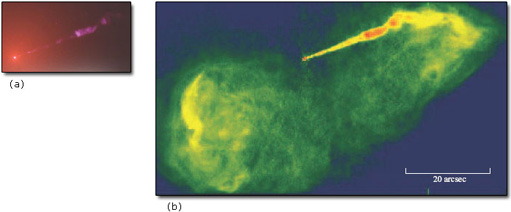3.4 Radio galaxies
Radio galaxies were discovered accidentally by wartime radar engineers in the 1940s, although it took another decade for them to be properly studied by the new science of radio astronomy. Radio galaxies dominate the sky at radio wavelengths. They show enormous regions of radio emission outside the visible extent of the host galaxy - usually these radio lobes occur in pairs.
The first radio galaxy to be discovered, and still the brightest, is called Cygnus A (Figure 20). Radio maps show the two characteristic lobes on either side of a compact nucleus. A narrow jet is apparent to the right of the nucleus and appears to be feeding energy out to the lobe. There is a hint of a similar jet on the left. Jets are a common feature of radio galaxies, especially at radio wavelengths. They trace the path by which material is being ejected from the AGN into the lobes.
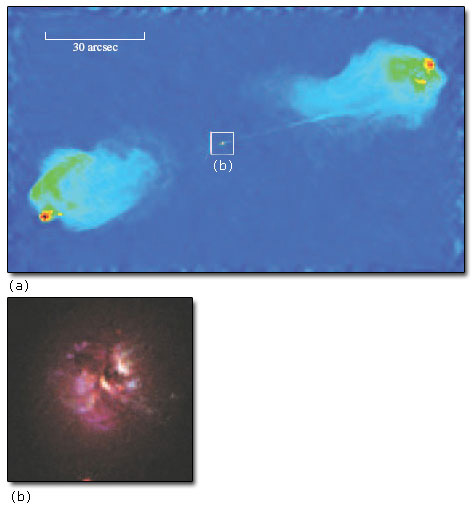
Cygnus A is an example of the more powerful class of radio galaxy with a single narrow jet. The second jet is faint, or even absent, in many powerful radio galaxies; we will consider the reasons for this shortly. Note the relatively inconspicuous nucleus and the bright edge to the lobes, as if the jet is driving material ahead of it into the intergalactic medium.
The jets of weaker radio galaxies spread out more and always come in pairs. These galaxies have bright nuclei, but the lobes are fainter and lack sharp edges. You can see an example in Figure 21. This is M84, a relatively nearby radio galaxy in the Virgo cluster of galaxies.
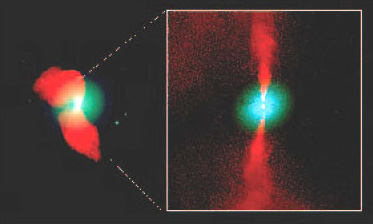
Each radio galaxy has a point-like radio nucleus coincident with the nucleus of the host galaxy. It is this feature that is reminiscent of other classes of active galaxies and which is believed to be the seat of the activity. The nucleus shows many of the properties of other AGNs, including emission lines, a broadband spectrum which is far wider than that of a normal galaxy, and variability.
The optical spectrum of the nucleus of a radio galaxy looks very much like that of any other AGN. Like Seyferts, radio galaxies can be classified into two types depending on whether broad lines are present (broad-line radio galaxies) or only narrow lines (narrow-line radio galaxies). Figure 22 shows an example of a spectrum of a broad-line radio galaxy.
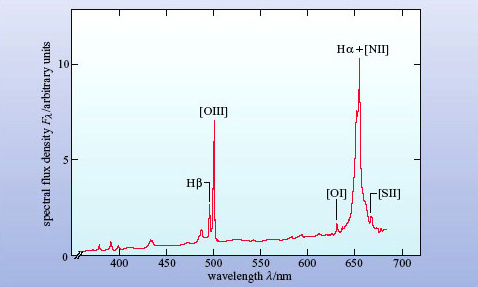
Figure 23 shows maps of radio, optical and X-ray wavelengths of Centaurus A, which is the nearest radio galaxy to the Milky Way. The optical image (Figure 23b) shows that it is an elliptical galaxy with a dust lane bisecting it.
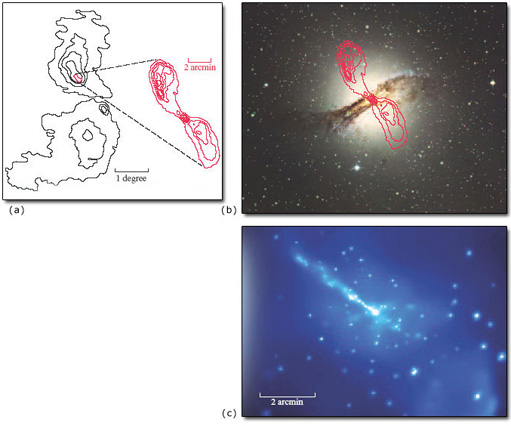
Given that Centaurus A is an elliptical galaxy, does anything strike you as incongruous about Figure 23b?
Elliptical galaxies are supposed to have negligible amounts of dust, so the thick dust lane seems very strange indeed!
The galaxy is obviously not a normal elliptical and this is a clue to the nature of radio galaxies. In fact, it is now thought that Centaurus A was formed by the collision of a spiral galaxy with a massive elliptical, the dust lane being the remains of the spiral's disc. We will come back to this interesting topic later in the course.
M87 (also known as Virgo A) is such a well-known radio galaxy that it must be mentioned at this point. In the optical region it, too, appears as a giant elliptical galaxy at the centre of the nearby Virgo cluster of galaxies. It seems that most radio galaxies are ellipticals. The single bright jet in the galaxy (Figure 24) is reminiscent of the jet in the quasar 3C 273 shown in Figure 18.
